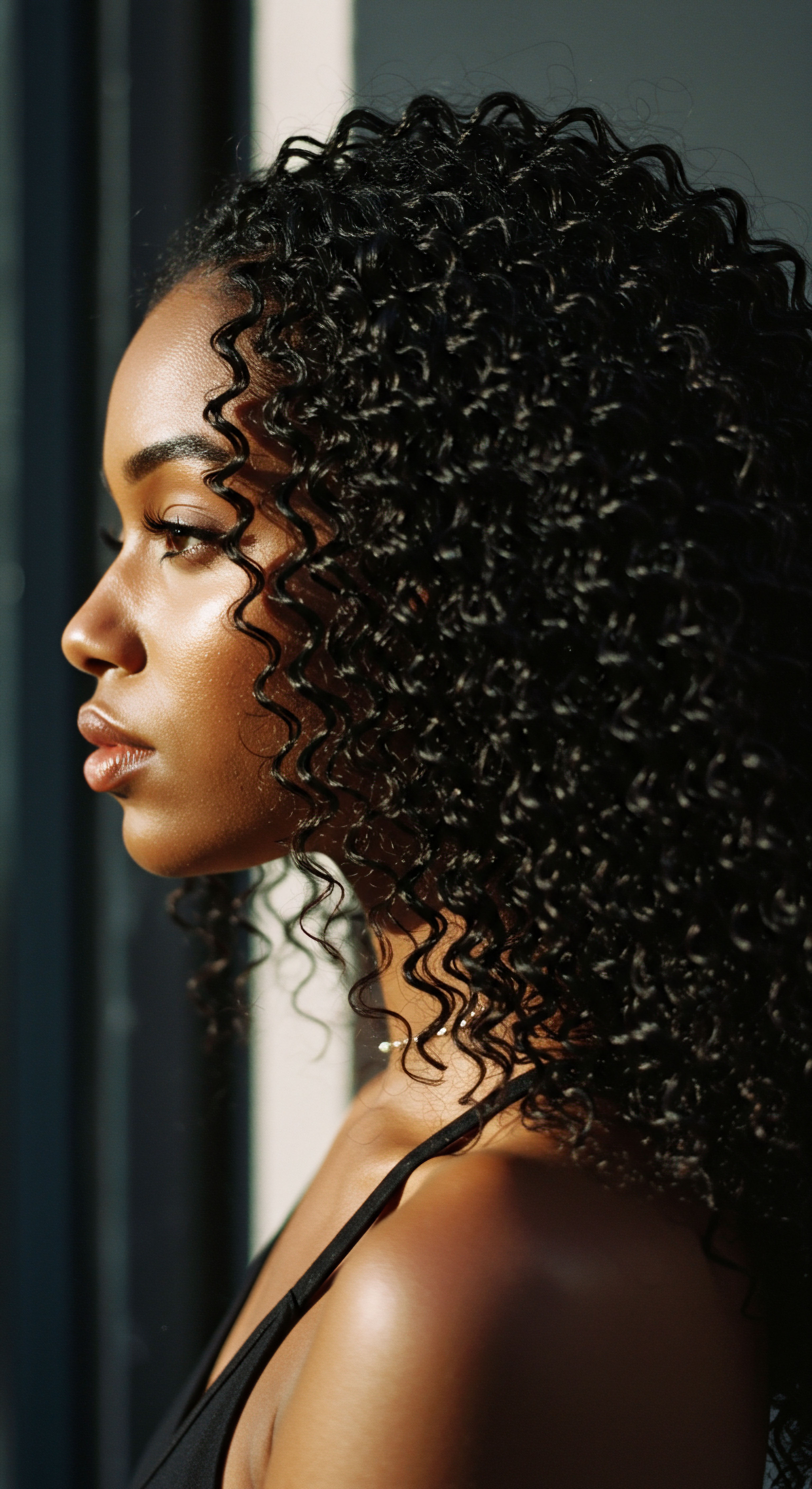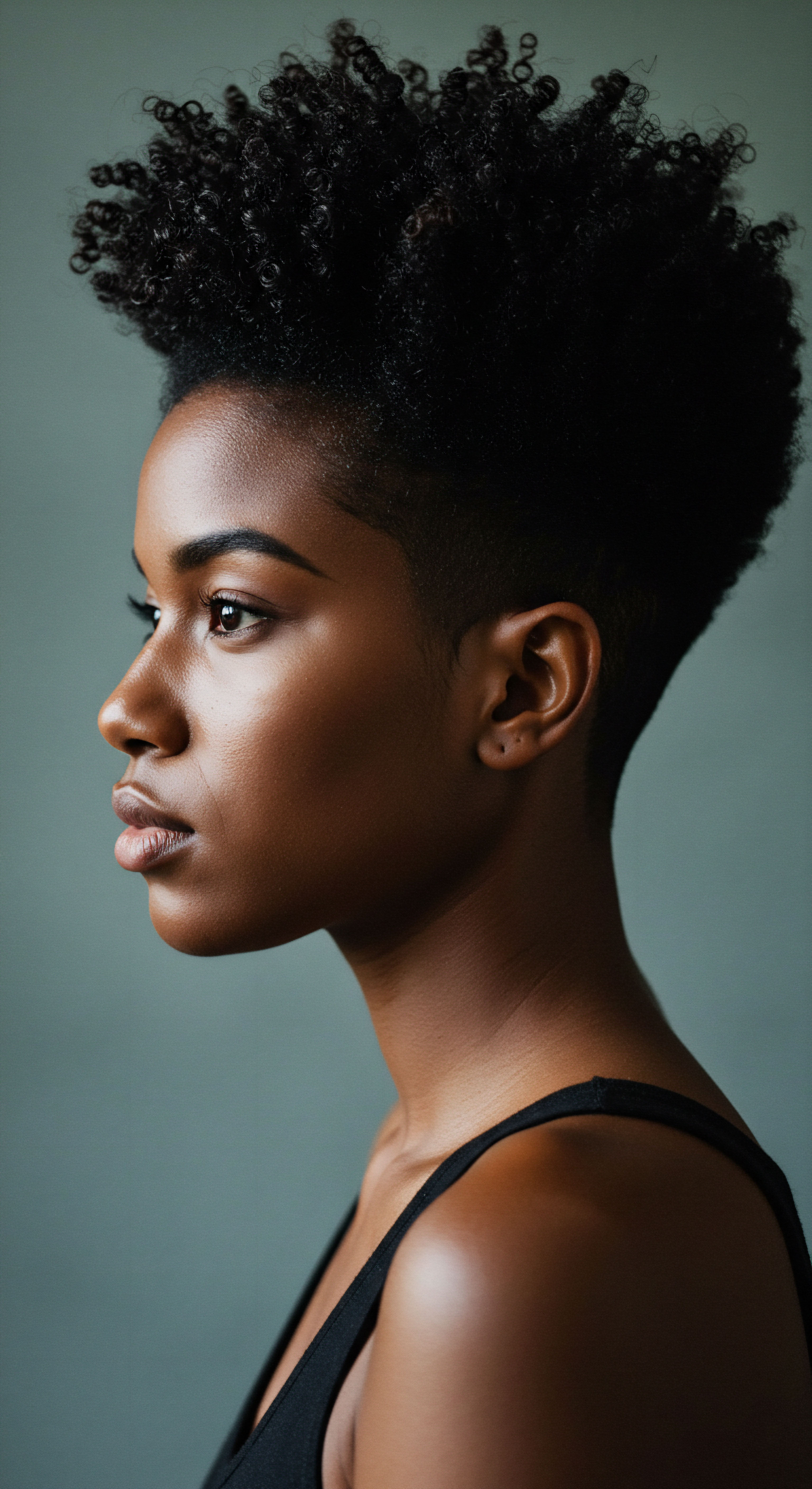
Roots
The quiet moments of rest, the deep hush of nightfall, have always held a particular power, not just for the weary spirit, but for the very strands that adorn our heads. From ancient times, across continents and through shifting eras, human societies have intuitively recognized a profound connection between the restorative period of sleep and the vitality of hair. It is a link whispered through generations, often codified in rituals, even when the underlying biological mechanisms remained a mystery. We are invited to consider hair not merely as an aesthetic feature, but as a living part of us, responsive to the rhythms of day and night, intimately tied to our well-being.
This understanding, sometimes cloaked in lore and sometimes in nascent science, points to a fundamental truth ❉ hair, like the body it grows from, requires moments of quiet repose to flourish. The wisdom of our ancestors, particularly those with textured hair, often saw the night as a sanctuary, a time for gentle preservation and preparation. This perspective offers a warm, knowing embrace of hair care that extends beyond mere styling, reaching into the deeper currents of self-care and the rhythms of life.

Historical Understandings of Hair Vitality
Across various cultures, hair was frequently seen as a repository of strength, beauty, and even spiritual power. Its health was often a mirror to overall physical condition and inner balance. For instance, in many African societies, hair was a direct link to ancestry and community, with specific styles conveying social status, age, or marital state.
Preserving this vital aspect meant attending to its needs constantly, including during the hours of slumber. The understanding was often that neglecting hair at night would compromise its inherent strength and beauty, much like neglecting the body’s need for rest would compromise health.
The concept of “beauty sleep” is not a modern invention. Renaissance-era texts, for example, reveal a preference for washing hair in the evening, presumably to avoid sleeping with wet hair, suggesting an awareness of how the state of hair at bedtime could affect its appearance and health upon waking. This practical advice, rooted in observation, reflects a long-standing recognition that the night hours offered a unique window for hair maintenance.

Early Hair Care Practices and Rest
Even in periods where hygiene practices differed greatly from our own, the care of hair before bed held a place of significance. Medieval practices, though sometimes surprising to modern sensibilities, often involved extensive combing routines before sleep. This was not simply about tidying; it was a way to distribute natural oils, remove dust, and stimulate the scalp.
One could argue this served as a precursor to modern dry shampoo, as powders were sometimes applied to hair before sleep to absorb oils and add fragrance. These methods aimed to keep hair presentable and healthy without frequent washing, making nighttime preparation even more crucial.
For women with longer hair, braiding it before sleep was a common practice. This simple act served a dual purpose ❉ it prevented tangles and protected the hair from friction throughout the night. This mechanical protection, born of necessity and observation, speaks to an intuitive grasp of how undisturbed rest could preserve hair’s integrity. The gentle containment offered by braids or loose twists meant less breakage and a smoother morning detangling process.
Ancient wisdom and historical practices reveal a persistent recognition that hair, like the body, requires restorative rest to maintain its vitality and beauty.
| Era or Culture Renaissance Europe |
| Common Nighttime Practice Evening hair washing, powder application, head coverings |
| Perceived Benefit Avoided sleeping with wet hair, added fragrance, absorbed oils, maintained appearance. |
| Era or Culture Medieval Europe |
| Common Nighttime Practice Extensive combing, braiding, nightcaps |
| Perceived Benefit Reduced tangles, distributed oils, protected from external elements. |
| Era or Culture Traditional African Cultures |
| Common Nighttime Practice Hair wrapping, protective styles (braids, twists) |
| Perceived Benefit Preserved moisture, minimized breakage, maintained style, cultural connection. |
| Era or Culture Victorian/Edwardian Era |
| Common Nighttime Practice Brushing, scalp massage, nightcaps (often silk) |
| Perceived Benefit Stimulated scalp, distributed oils, prevented tangles, added gloss. |
| Era or Culture Ayurvedic Traditions (India) |
| Common Nighttime Practice Oil application (scalp massage), specific sleep durations |
| Perceived Benefit Nourished roots, improved blood flow, reduced stress, promoted hair growth. |

Ritual
As the day fades and the quiet promise of night settles, our attention often turns inward, towards the routines that prepare us for rest. For textured hair, these evening moments hold particular weight, transforming from simple tasks into deliberate acts of care. The history of hair care before sleep is rich with such rituals, practices that moved beyond mere necessity to become expressions of preservation, comfort, and sometimes, even spiritual grounding. We consider how these actions, repeated night after night, shaped not only the physical state of hair but also the very experience of rest itself.
These nighttime preparations, often gentle and slow, provided a contrast to the demands of the day. They offered a period for hair to be undisturbed, to absorb nourishment, and to avoid the friction and tension that daily activities could bring. From the meticulous wrapping of coils to the anointing of scalps with oils, these rituals across time speak to a deep understanding of hair’s delicate nature and its need for nocturnal protection.

What Nighttime Practices Protected Hair Across Time?
One of the most widely observed historical practices linked to sleep and hair care involves various forms of head coverings. From the Renaissance to the Victorian era, and continuing vibrantly in many cultures today, the use of nightcaps, bonnets, and scarves served as a primary means of protection. In Renaissance Europe, after powders were applied to hair, head coverings were worn to sleep, helping to maintain the look and fragrance of the hair. Later, Victorian and Edwardian women used nightcaps, often silk, to keep hair tangle-free and impart a glossy appearance.
For individuals with textured hair, particularly within Black communities, the practice of covering hair at night with silk scarves or satin bonnets has been a generational wisdom, a cherished rite of passage. This practice helps preserve moisture, minimizes breakage from friction against pillowcases, and maintains hairstyles, allowing for less manipulation during waking hours. It speaks to a profound understanding of how to safeguard the unique properties of textured hair.
- Head Coverings ❉ Bonnets, scarves, and nightcaps offered protection from friction and helped preserve styles and moisture.
- Braiding ❉ Simple braids or twists before bed reduced tangles and protected hair from movement during sleep.
- Oiling the Scalp ❉ Massaging the scalp with natural oils nourished roots and stimulated blood flow, often done as a nightly or weekly ritual.

How Did Different Cultures Prepare Hair for Rest?
The diversity of human cultures yielded a spectrum of approaches to nighttime hair care. In Ayurvedic traditions from India, hair health is deeply tied to overall mind-body balance, and adequate sleep is considered essential. Nightly or regular scalp massages with oils such as coconut, sesame, or almond oil are recommended not only for hair health but also for inducing sound sleep and reducing stress. This holistic approach sees hair care before bed as a calming ritual that benefits both the hair and the sleeper’s well-being.
Medieval practices, often driven by the need to maintain hair between less frequent washes, included thorough combing and braiding. A hairstylist who experimented with medieval hair care methods found that braiding hair before sleep significantly reduced tangles and kept the scalp feeling clean, even without daily washing. This practical application of historical methods demonstrates their enduring efficacy.
Nighttime hair care rituals, whether through protective coverings or nourishing applications, have historically served as a quiet act of preservation and self-regard.
The conscious choice of sleep surface also appears in historical accounts and continues today. While silk and satin pillowcases are often touted as modern solutions for reducing hair friction, the underlying principle of a smooth surface to protect hair has likely been understood implicitly for centuries, contributing to the preference for certain head coverings. The continuity of these practices, from ancient methods of containment to modern material choices, underscores a consistent human impulse to shield hair during rest.
| Technique Protective Braiding/Twisting |
| Description Hair gathered into loose braids or twists to prevent tangles and breakage. |
| Historical Context / Cultural Link Common across various cultures, including Medieval Europe and African diasporic traditions. |
| Technique Scalp Oiling and Massage |
| Description Application of natural oils to the scalp, often accompanied by gentle massage. |
| Historical Context / Cultural Link Central to Ayurvedic hair care for nourishment and promoting sleep. |
| Technique Head Wrapping/Covering |
| Description Using fabric (silk, satin, linen) to cover and secure hair. |
| Historical Context / Cultural Link Prevalent in Renaissance Europe (for powder retention), Victorian era (nightcaps), and Black hair care traditions (bonnets, scarves). |
| Technique Dry Combing/Brushing |
| Description Thoroughly combing or brushing hair to remove debris and distribute natural oils. |
| Historical Context / Cultural Link A primary method of hair cleaning and conditioning in Medieval times. |

Relay
The quietude of night, far from being a passive state, represents a period of profound activity within the body, a symphony of restoration that deeply impacts our hair. Historical hair care practices, often developed through generations of keen observation, frequently aligned with these unseen biological rhythms, even without the language of modern science to explain them. We now understand that the gentle acts of preparation before sleep, passed down through time, offered hair a true advantage, supporting its natural growth cycles and mitigating daily stresses. This connection between rest and hair vitality extends beyond superficial beauty, reaching into the very cellular processes that sustain healthy strands.
Consider the intricate dance of hormones and cellular repair that unfolds as we sleep. Our hair follicles, those tiny organs responsible for producing each strand, are not dormant during these hours. They are actively engaged in processes of regeneration and growth, processes that are optimized by quality rest. The wisdom of ancient traditions, whether by intent or happy coincidence, provided an environment where these vital nocturnal functions could proceed with minimal disruption.

How Does Sleep Influence Hair Follicle Health?
Sleep is a period of cellular repair and regeneration for the entire body, including hair follicles. During deep sleep, particularly the non-REM stage, the body actively works to repair damaged cells and tissues. This restorative phase is crucial for the hair growth cycle, influencing the activity of hair follicles in the anagen (active growth) phase. Disrupted sleep can shorten this growth phase, potentially leading to slower hair growth or increased shedding over time.
Hormonal balance plays a significant role here. Sleep regulates essential hormones like melatonin and growth hormone, both of which are critical for hair health. Melatonin, often called the “sleep hormone,” also stimulates hair follicles and helps extend the anagen phase. Growth hormones, released during deep sleep, are vital for cell regeneration, including the repair and growth of hair follicles.
Conversely, insufficient sleep can lead to elevated levels of cortisol, a stress hormone. High cortisol can push hair follicles into a premature resting phase, causing increased shedding, a condition known as telogen effluvium.
A 2019 study published in Cell Reports linked circadian rhythm disruptions, such as those experienced by shift workers, to decreased stem cell activity in hair follicles. This research indicates that chronic disruption can reduce the regenerative capacity of these cells over time, resulting in thinner, weaker hair. This scientific observation lends credence to the historical understanding that a regular, undisturbed period of rest is beneficial for hair vitality.

Do Historical Practices Align with Modern Hair Biology?
Many historical nighttime hair care practices, while not explicitly understood through a biological lens at the time, nonetheless supported the physiological processes now known to promote hair health during sleep.
- Minimizing Friction ❉ The use of silk nightcaps, satin bonnets, or loose braids directly addressed the problem of friction. Modern science confirms that friction from cotton pillowcases can cause breakage, tangles, and frizz, especially for textured hair. By creating a smooth, protective barrier, these historical coverings allowed hair to glide rather than snag, preserving its integrity during the tossing and turning of sleep.
- Scalp Stimulation and Oil Distribution ❉ Regular combing and scalp massages, common in many historical routines, stimulated blood flow to the scalp. This increased circulation delivers oxygen and nutrients to hair follicles, essential for healthy growth. The distribution of natural oils or applied treatments also created a protective layer, sealing in moisture and conditioning the hair overnight.
- Stress Reduction ❉ Many historical nighttime rituals, particularly those involving gentle massage and quiet preparation, served as calming, self-soothing practices. Modern research strongly links stress to hair loss, with elevated cortisol levels disrupting the hair growth cycle. Practices that reduced stress before bed would have inadvertently lowered cortisol, creating a more favorable environment for hair health.
The careful routines of past generations, from protective coverings to nourishing oils, provided an intuitive shield for hair, aligning with its natural rhythms of renewal during slumber.
A particularly compelling, if less common, historical practice relates to the concept of “airing” the hair. Victorian and Edwardian texts suggested that hair should be “aired” at night, sometimes after massage, rather than remaining tightly styled. This practice, perhaps aimed at preventing scalp issues or simply refreshing the hair, aligns with modern understanding of scalp health. A healthy scalp environment, with proper air circulation, can reduce the risk of microbial imbalances and support follicular function, contributing to overall hair vitality.
The role of sleep in hair health extends to aspects like hair pigmentation. Melatonin, the sleep hormone, also influences melanin production, the pigment responsible for hair color. As melatonin levels naturally decline with age, this contributes to hair graying. Some research indicates that melatonin supplementation might help restore hair pigmentation by stimulating melanin production.
Disrupted sleep patterns can disturb melatonin production, affecting the balance of melanin in hair follicles. This suggests that historical practices promoting restful sleep may have, without direct knowledge, also played a part in maintaining hair color for longer.
| Biological Factor Hair Growth Cycle |
| Effect of Adequate Sleep Supports and prolongs the anagen (growth) phase. |
| Consequence of Poor Sleep Disrupts the cycle, pushing follicles prematurely into the telogen (resting/shedding) phase. |
| Biological Factor Hormonal Balance |
| Effect of Adequate Sleep Optimizes melatonin and growth hormone production. |
| Consequence of Poor Sleep Elevates cortisol (stress hormone), leading to telogen effluvium and other hair loss types. |
| Biological Factor Blood Circulation |
| Effect of Adequate Sleep Increases blood flow to the scalp, delivering nutrients and oxygen. |
| Consequence of Poor Sleep Reduces blood flow, depriving follicles of essential nourishment. |
| Biological Factor Cellular Regeneration |
| Effect of Adequate Sleep Facilitates repair and regeneration of hair follicle cells. |
| Consequence of Poor Sleep Hinders regenerative processes, leaving follicles vulnerable to damage. |
| Biological Factor Immune System Function |
| Effect of Adequate Sleep Supports a healthy immune response, reducing inflammation. |
| Consequence of Poor Sleep Weakens immunity, potentially exacerbating scalp conditions or autoimmune hair loss. |

Reflection
The quiet hours of night have long held a secret language for our hair, a conversation of rest and renewal that spans centuries. From the delicate rituals of protective wraps and soothing oils to the profound biological processes that unfold within our follicles as we sleep, the historical journey of hair care reveals an enduring wisdom. It speaks to a deeper connection between our rest and our inherent radiance, a recognition that true beauty often begins in stillness.
Our ancestors, through their thoughtful evening routines, understood something elemental about nurturing hair ❉ that it thrives not only in the light of day’s attention but also in the gentle embrace of night’s repose. This understanding invites us to reconsider our own nightly habits, finding a harmonious balance between ancient wisdom and modern insights for the health of our hair.

References
- Ablon, Glynis. “A 3-Month, Randomized, Double-Blind, Placebo-Controlled Study Evaluating the Ability of an Extra-Strength Marine Protein Supplement to Promote Hair Growth and Decrease Shedding in Women with Self-Perceived Thinning Hair.” Journal of Clinical and Aesthetic Dermatology, vol. 8, no. 10, 2015, pp. 28–34.
- Al-Nuaimi, Y. et al. “Hair Follicles as a Critical Model for Monitoring the Circadian Clock.” Journal of Investigative Dermatology, vol. 143, no. 1, 2023, pp. 109-118.
- Della Porta, Giambattista. Natural Magick. 1558. (Referenced in discussions of Renaissance beauty practices).
- Giacometti, Paolo. The Art of Hair ❉ The Hairdresser’s Guide to Historical Hairdressing. 2005.
- Hardman, Jonathan A. et al. “Circadian Clock Control of Hair Follicle Stem Cell Activation.” Cell Reports, vol. 28, no. 3, 2019, pp. 741-753.e5.
- Marinello, Giovanni. Le medicine particolari. 1562. (Referenced in discussions of Renaissance beauty practices).
- Paus, Ralf, and George Cotsarelis. “The Biology of Hair Follicles.” New England Journal of Medicine, vol. 341, no. 7, 1999, pp. 491-497.
- Randall, Valerie A. “Androgens and Hair Growth ❉ An Update.” Hormone Research, vol. 54, no. 5, 2000, pp. 267-274.
- Sharma, H. Ayurvedic Healing ❉ A Comprehensive Guide. Singing Dragon, 2011.
- Tobin, Desmond J. “Melanin ❉ Hair Color and Skin Pigmentation.” Journal of Cosmetic Dermatology, vol. 4, no. 1, 2005, pp. 1-7.